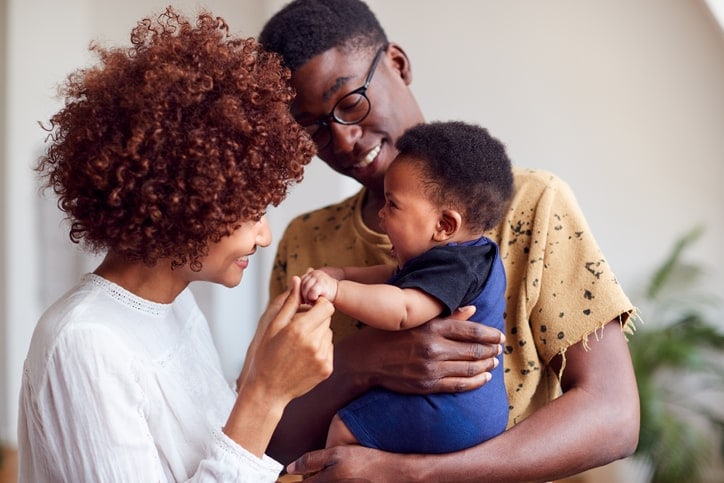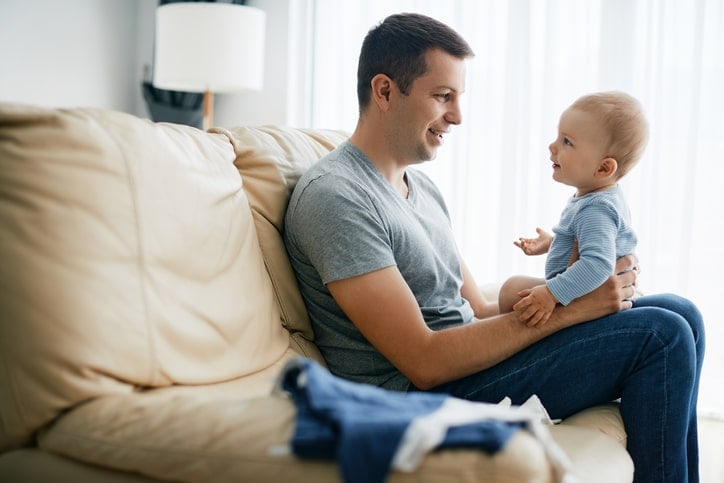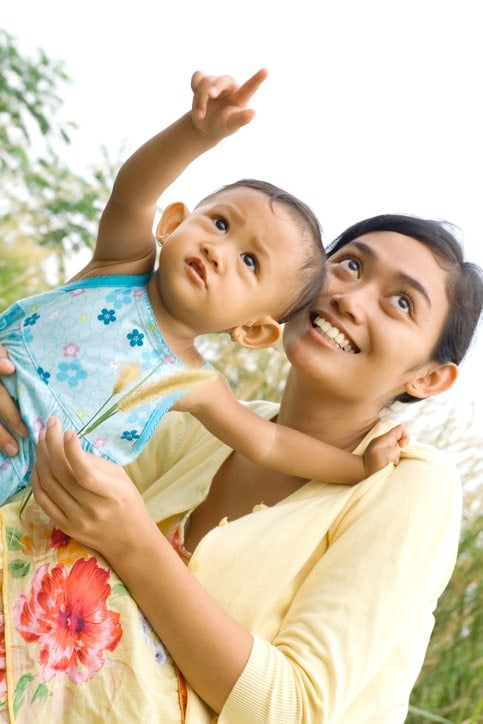Babies possess amazing learning abilities. But to master language, they need our help. Studies suggest we can support language development by engaging babies in conversation, and by providing them with a variety of special cues and communicative experiences.
Where to begin? Check out these evidence-based tips.


Tip #1: Embrace “infant-directed speech”
Many people find themselves changing their speech patterns when they address a baby. They may adopt a higher pitch, and their voices may take on a more musical, variable tone. They tend to speak more slowly, too, and repeat certain key words over and over again.
Is it mere silliness? On the contrary. Researchers have evidence that this “infant-directed speech” helps babies understand our emotional states. It may also help babies pick out individual words and decipher their meanings.
Learn more in my article, “Baby communication: Why your baby prefers infant-directed speech”, where I discuss the attention-getting features of this mode of speaking. In addition, check out my article, “Baby talk 101: How infant-directed speech helps babies learn language”, where I review the ways that infant-directed speech helps babies identify specific sounds and words.
Tip #2: Respond appropriately to your baby’s moods and signals — just as you would to an older individual.
When we communicate with an adult friend, we take it for granted that they will acknowledge our moods and states and attempts to express ourselves. If we’re excited and happy, we expect them to mirror some of this back to us. If we’re anxious or upset, we expect them to acknowledge this, and try soothe. If we’re tired, frazzled, or overstimulated, we hope that a good friend will notice, and give us some space to unwind.
When parents are tuned into to their babies’ states – and respond by acknowledging infant signals with appropriate gaze, vocalizations, positive emotions, and affectionate touch – researchers call this “caregiver sensitivity.” It’s a basic building block of communication and attachment security, and, from the standpoint of both socio-emotional functioning and language development, it’s never too early to show this sensitivity.
In a recent study of 40 infants, researchers observed mothers and babies interacting at 3 months postpartum, and then checked back when the infants were toddlers. Babies who had experienced greater maternal sensitivity at 3 months developed more advanced language development at 18 and 30 months (Endevelt-Shapira et al 2024). Read more about the power of sensitivity in my articles about “mind-minded parenting” and “brain-to-brain synchrony.”
Tip #3: Talk back to babies when they vocalize or babble
All around the world, babies typically follow the same pattern: Between 5 and 10 months they begin to repeat some of simple syllables they hear, like “ba ba ba ba” (Lang et al 2019).
This is called “canonical babbling,” and you might think of it as a one-way phenomenon: Babies babble, and we listen. But experiments confirm that babies are paying attention to our reactions to their vocalizations. In one study, mothers were asked to imitate the babbled syllables they heard their babies making. The babies responded by doubling down — focusing more intensely on producing syllables. So it looks like we can encourage our babies to practice speech-like sounds by repeating some of the syllables they babble (Goldstein and Shwade 2008; Emlinger et al 2019).
Moreover, when babies direct their vocalizations at a specific object, we can take that as a cue to start talking with them about that object (Albert et al 2018). We can expand on whatever it is we suspect the baby is trying to communicate (Lieberman et al 2019). “Oh! You like the banana? Do you want the banana? Let’s eat the banana!”
The bottom line? Babies are busy learning language long before they speak their first words. And experts advise that talking with babies — responding to their babbling and communication attempts — is a crucial way for babies to learn about the sounds and meanings of language.
Tip #4: Support language development with lots of one-on-one conversation


Babies can learn something from “eavesdropping” on other people’s discussions. But when it comes to learning language quickly and efficiently, there may be nothing quite as powerful as direct participation in a genuine, one-on-one conversation (Tamis-Lemonda et al 2014).
For instance, in modern, industrialized countries — and in some traditional, agrarian communities as well — you can observe a similar pattern: When children log more conversation time, their language skills seem to get a special boost (Frank et al 2021; Newman et al 2016; Shneidman and Goldin-Meadow 2012).
And when researchers have actively coached new parents to engage their babies in high-quality conversations — taking turns, and emphasizing the features of “infant-directed speech” — babies have ended up with better language outcomes (Ferjan Ramírez et al 2019; Ferjan Ramírez et al 2020; Garcia et al 2019).
Tip #5: Use this as a reminder to make your conversations more effective and rewarding
Some child psychologists use the acronym “PRIDE” to get the point across. Babies benefit when we
- PRAISE them;
- REFLECT on their speech (or attempts at speech) with appropriate verbal responses;
- IMITATE their playful behaviors;
- DESCRIBE their behavior as you talk with them (“Oh! You’re rolling the ball!”); and
- show ENTHUSIASM or enjoyment (Wow! That’s great!”).
Why? If you do these things, you’ll be engaging your baby in conversation, and we’ve already noted how that’s helpful. But the PRIDE approach is valuable in other ways, too. It can help inspire emotional closeness and good moods, making communication feel more rewarding. It may also make it easier for your baby to discover the usefulness of language — not only for naming objects, but also for expressing feelings and desires
In support of these ideas, researchers have noticed that babies tend to develop better language skills when their parents respond to them in a sensitive, positive manner (e.g., Madigan et al 2019; Garcia et al 2019). And there is experimental evidence too: In studies tracking infants at risk for behavior problems, researchers randomly assigned some parents to receive training in the “PRIDE” technique. The results? Compared with infants in control groups, babies with trained parents tended to experience greater increases in language production over time (Garcia et al 2015 and Bagner et al 2016).
Tip #6: Leverage the power of curiosity. Look for these signs!


We’re more likely to learn when we’re actively interested or curious, and this is true of babies as well as adults. So when your baby is really interested in something, that’s the best possible time talk about it. Your baby is highly motivated, and by responding promptly, you are making it easier for your baby to map new words to their meanings.
But how can you tell if a baby is interested? When researchers have watched interactions between mothers and infants, most mothers seemed to know: Mothers were more likely to name an object if they saw their babies looking at it or vocalizing — just the right timing for helping their babies learn (Tamis-Lemonda et al 2014; Chang et al 2016).
Another big clue? When your baby points at something. Most babies start pointing at objects before their first birthdays, and fascinating experiments suggest that babies make use of pointing — at least in part — to get us to share interesting new verbal information about things (Kovacs et al 2015; Lucca and Wilbourn 2018; Lucca and Wilbourn 2019).
Tip #7: Seize the moment when you baby is both looking at an object and physically handling it. This is when your baby is especially receptive to learning the object’s name.
Pointing is a strong indicator that your baby is curious about something. But it isn’t the only one. Another solid marker of interest is if your baby is both looking at something and touching it with his or her hands.
When babies are fully engaged in this way, they may be particlarly ready to learn.
For instance, imagine your baby picks up a plastic dinosaur. She’s looking at it, and feeling it’s texture with her hands. Then — just 3 seconds later — she hears you say the word, “dinosaur”, as you talk to her about it.
When researchers studied this type of scenario, they found clear evidence that multiple modes of attention matter. When babies (aged 12-26 months) were engaged in a combination of visual and “hands-on” exploration of an object, they were much more likely to learn the word for it (Schroer and Yu 2023). By contrast, babies didn’t show enhanced learning if they had merely been looking at the object (no touching) or just touching the object (not looking).
Tip #8: Use gestures, and encourage your baby to use gestures
Pointing is a simple gesture that can make communication more clear. But there are others. And studies indicate that babies learn language more easily from people who incorporate such gestures into their speech. There is also evidence that babies have better language outcomes if they themselves use lots of gestures. Read more about it in my article, “The science of gestures: We learn faster when we talk with our hands.”
Tip #9: Engage your baby in playful music activities
Music and language both make use of tones and rhythms, and some of the same parts of the brain that process music also process speech. So can exposing you baby to music — teaching your baby to pay attention to the features of music — support language development?
As I note in another Parenting Science article, there’s reason to think so. When researchers assigned babies to participate in certain musical activities, these children went on to acquire more advanced language skills. Which kinds of activities are likely to help? Experiments suggest a variety of approaches, including bouncing your baby to the rhythm, encouraging your baby to shake a maraca or rattle to keep time, and playing music-based games (like dancing when the music plays and freezing when it stops). For the full story, see my article, “Can musical training help babies learn language?”
Tip #10: Read to your baby
It might seem that babies are too young to benefit from storybooks. But there are undeniable links between shared storybook reading and child language development (Flack et al 2018), and it makes sense that shared reading could contribute to a boost in language skills: It can expose young children to a more varied vocabulary.
For instance, in one study, researchers watched how parents interacted with their toddlers under two different conditions — while reading a storybook, and while watching a television program together. Parents used richer, more complex language during storybook time (Hanson et al 2021).
Then there’s additional possibility: If we make our babies feel that reading books is fun, we may be laying the groundwork for our children to really engage themselves — to talk with us during the storytelling, to make comments about the content, to share their own ideas. In a recent study, researchers found that this sort of engagement was linked with toddlers’ emerging language skills (Dicataldo and Roch 2022).
Tip #11: Respect the power of sleep
As I explain in another Parenting Science article, babies are more likely to retain newly-encoded information if they sleep shortly after learning. Does this mean you should try to pressure your baby to take naps? No. But it suggests that the last 30-60 minutes before sleep are especially fruitful times for us to expose babies to language. It gives credence to the practice of reading bedtime stories…and to other, pre-sleep conversational routines. For more information about this interesting learning phenomenon, see my article, “Naps help babies learn and remember”.
More about your baby’s language development
You can find more evidence-based information in these Parenting Science articles:
In addition, if you’re interested in other aspects of your baby’s development, check out these offerings:
References: How to support language development in babies
Albert RR, Schwade JA, Goldstein MH. 2018. The social functions of babbling: acoustic and contextual characteristics that facilitate maternal responsiveness. Dev Sci. 21(5):e12641. d
Anderson NJ, Graham SA, Prime H, Jenkins JM, Madigan S. 2021. Linking Quality and Quantity of Parental Linguistic Input to Child Language Skills: A Meta-Analysis. Child Dev. 92(2):484-501.
Bagner DM, Garcia D, Hill R. 2016. Direct and Indirect Effects of Behavioral Parent Training on Infant Language Production. Behav Ther. 47(2):184-97.
Begus K, Gliga T, Southgate V. 2014. Infants learn what they want to learn: responding to infant pointing leads to superior learning. PLoS One. 9(10):e108817. d
Canfield CF, Miller EB, Shaw DS, Morris P, Alonso A, Mendelsohn AL. 2020. Beyond language: Impacts of shared reading on parenting stress and early parent-child relational health. Dev Psychol. 56(7):1305-1315.
Chang L, de Barbaro K, Deák G. 2016. Contingencies Between Infants’ Gaze, Vocal, and Manual Actions and Mothers’ Object-Naming: Longitudinal Changes From 4 to 9 Months. Dev Neuropsychol. 41(5-8):342-361.
Demir-Lira ÖE, Applebaum LR, Goldin-Meadow S, Levine SC. 2019. Parents’ early book reading to children: Relation to children’s later language and literacy outcomes controlling for other parent language input. Dev Sci. 22(3):e12764.
Dicataldo R and Roch M. 2022. How Does Toddlers’ Engagement in Literacy Activities Influence Their Language Abilities? Int J Environ Res Public Health.;19(1):526.
Elmlinger SL, Schwade JA, Goldstein MH. 2019. The ecology of prelinguistic vocal learning: parents simplify the structure of their speech in response to babbling. J Child Lang. 46(5):998-1011.
Endevelt-Shapira Y, Bosseler AN, Mizrahi JC, Meltzoff AN, and Kuhl PK. 2024. Mother-infant social and language interactions at 3 months are associated with infants’ productive language development in the third year of life. Infant Behav Dev. 75:101929.
Flack ZM, Field AP, Horst JS. 2018. The effects of shared storybook reading on word learning: A meta-analysis. Dev Psychol. 54(7):1334-1346
Garcia D, Rodriquez GM, Hill RM, Lorenzo NE, Bagner DM. 2019. Infant Language Production and Parenting Skills: A Randomized Controlled Trial. Behav Ther. 50(3):544-557.
Garcia D, Bagner DM, Pruden SM, Nichols-Lopez K. 2015. Language Production in Children With and At Risk for Delay: Mediating Role of Parenting Skills. J Clin Child Adolesc Psychol. 44(5):814-25.
Goldstein MH, Schwade JA. 2008. Social feedback to infants’ babbling facilitates rapid phonological learning. Psychol Sci. 19(5):515-23.
Hanson KG, Lavigne HJ, Gover SG, Anderson DR. 2021. Parent language with toddlers during shared storybook reading compared to coviewing television. Infant Behav Dev. 65:101646.
Heymann P, Heflin BH, Baralt M, and Bagner DM. 2020. Infant-directed language following a brief behavioral parenting intervention: The importance of language quality. Infant Behav Dev. 58:101419.
Hirai M, Kanakogi Y. 2019. Communicative hand-waving gestures facilitate object learning in preverbal infants. Dev Sci. 22(4):e12787.
Hsu HC, Iyer SN. Early gesture, early vocabulary, and risk of language impairment in preschoolers. Res Dev Disabil. 57:201-10
Jimenez ME, Reichman NE, Mitchell C, Schneper L, McLanahan S, Notterman DA. 2020. Shared Reading at Age 1 Year and Later Vocabulary: A Gene-Environment Study. J Pediatr. 216:189-196.e3.
Kovács ÁM, Tauzin T, Téglás E, Gergely G, Csibra G. 2014. Pointing as Epistemic Request: 12-month-olds Point to Receive New Information. Infancy. 19(6):543-557.
Lang S, Bartl-Pokorny KD, Pokorny FB, Garrido D, Mani N, Fox-Boyer AV, Zhang D, Marschik PB. 2019. Canonical Babbling: A Marker for Earlier Identification of Late Detected Developmental Disorders? Curr Dev Disord Rep. 2019;6(3):111-118.
Lieberman M, Lohmander A, Gustavsson L. 2019. Parents’ contingent responses in communication with 10-month-old children in a clinical group with typical or late babbling. Clin Linguist Phon. 33(10-11):1050-1062.
Lucca K and Wilbourn MP. 2018. Communicating to Learn: Infants’ Pointing Gestures Result in Optimal Learning. Child Dev. 89(3):941-960.
Lucca K and Wilbourn MP. 2019. The what and the how: Information-seeking pointing gestures facilitate learning labels and functions. J Exp Child Psychol. 178:417-436.
Madigan S, Prime H, Graham SA, Rodrigues M, Anderson N, Khoury J, Jenkins JM. 2019. Parenting Behavior and Child Language: A Meta-analysis. Pediatrics. 144(4):e20183556.
Morningstar M, Garcia D, Dirks MA, Bagner DM. 2019. Changes in parental prosody mediate effect of parent-training intervention on infant language production. J Consult Clin Psychol. 87(3):313-318.
Orr E. 2020. Object play as a mediator of the role of exploration in communication skills development. Infant Behav Dev. 60:101467.
Schroer SE and Yu C. 2023. Looking is not enough: Multimodal attention supports the real-time learning of new words. Dev Sci. 26(2):e13290.
Tamis-LeMonda CS, Kuchirko, Y, and Song L. 2014. Why is infant language learning facilitated by parental responsiveness? Curr. Dir. Psychol. Sci. 23: 121–126.
Weisleder A, Cates CB, Harding JF, Johnson SB, Canfield CF, Seery AM, Raak CD, Alonso A, Dreyer BP, Mendelsohn AL. 2019. Links between Shared Reading and Play, Parent Psychosocial Functioning, and Child Behavior: Evidence from a Randomized Controlled Trial. J Pediatr. 213:187-195.e1.
Zuccarini M, Guarini A, Iverson JM, Benassi E, Savini S, Alessandroni R, Faldella G, Sansavini A. 2018. Does early object exploration support gesture and language development in extremely preterm infants and full-term infants?J Commun Disord. 76:91-100
Content of “How to support language development in babies” last modified 10/2024. Portions of the text are derived from an earlier version of the article, written by the same author.
image of woman talking to infant while father holds him by monkeybusinessimages / istock
image of baby on father’s lap by Drazen Zigic / istock
image of baby pointing with mother watching by ampyang / istock